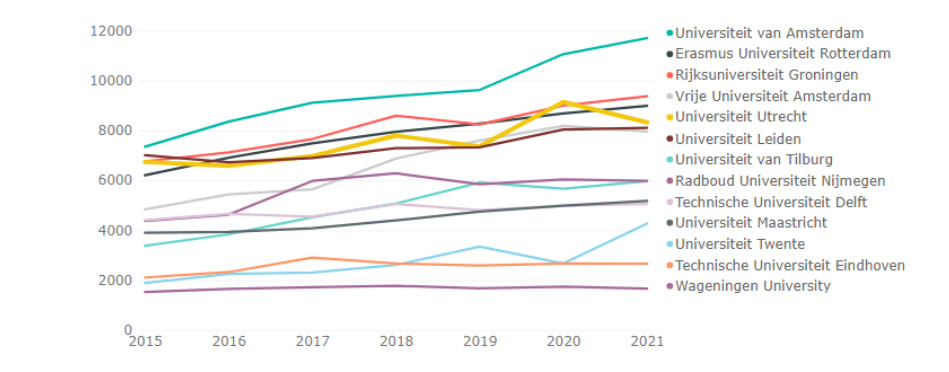UU keeps on growing: fewer first-year Bachelor’s students, more Master’s students
The number of new Bachelor's students joining UU this past September decreased by 7 percent compared to the beginning of the academic year 2020-2021, which saw a record number of first-year Bachelor's students: 8,243 to be exact. In September 2021, that number was down to 7,631.
It was already known that the UU wasn’t growing as fast as other Dutch universities, but an overview (only accessible to those with a Solis ID) sent to the University Council now shows all data in a graph.
This year, Social Sciences is the only faculty that has more Bachelor’s students enrolled than it did last year. Most of those students can be found in the programmes Interdisciplinary Social Sciences and Pedagogical Sciences. The faculties of Science and Geosciences show the sharpest drop (14 and 13 percent, respectively), after an explosive growth last year.

Number of first-year Bachelor’s students per university, 2015-2021. Source: Studielink, based on data on October 1. Graph from memo.
More Master's students
The number of Master’s students increased again. This academic year, 5,883 students started a Master’s programme in Utrecht. That's 10 percent more than in the previous year.
Social Sciences saw a 30 percent increase, mainly due to the popularity of the Clinical Psychology programme. Other faculties also experienced an increase in the number of Master’s students, with the exception of Humanities, which has remained stable.
The increase can partially be explained by a growth in the number of international students. The total number of foreigners enrolled at UU has risen by nearly a quarter to around 5,000. Currently, 13 percent of UU's students are not Dutch citizens.
In total, the number of students coming to Utrecht to study for the first year of their studies has remained mostly the same, with a small drop from 14,267 to 14,203 students.
UU to keep growing
The large influx of students in the past few years has posed numerous challenges to the university, as explained by the Executive Board in an interview with DUB last year. Finding enough rooms for all the classes is one of the biggest obstacles.
It looks like the obstacles are set to become even greater, as the university expects the influx of students — both national and international — to keep on growing. This year, the total number of enrolled students is 50 percent higher than in 2020-2021. The memo shows that this trend is not likely to stop before 2030, although the curve is set to flatten gradually.